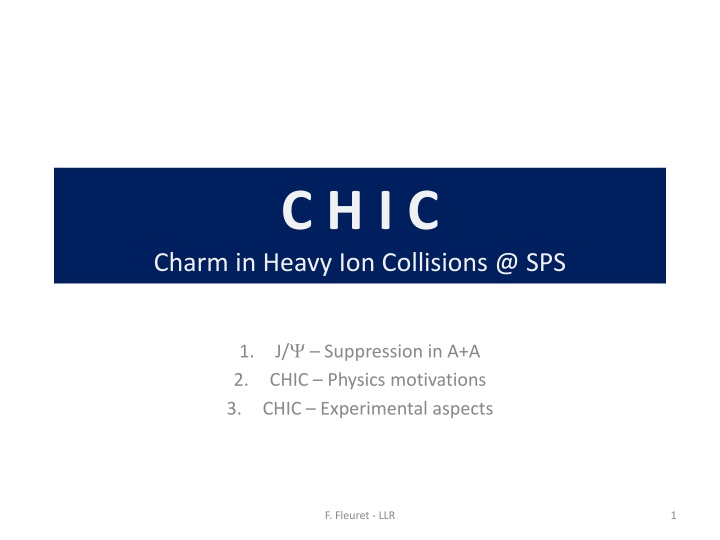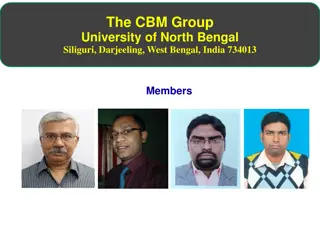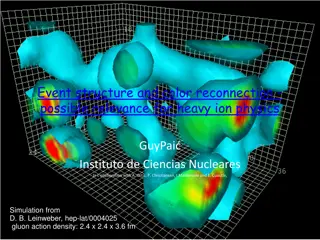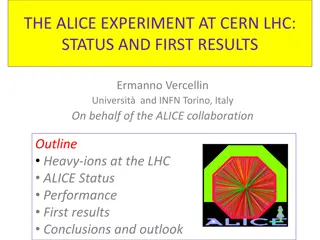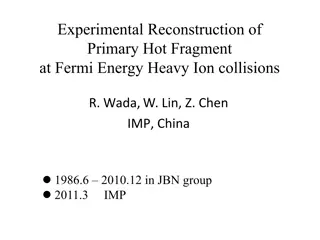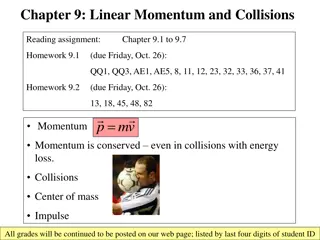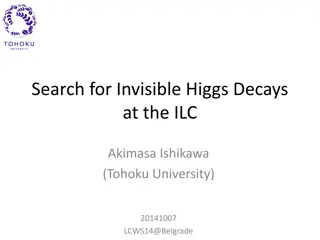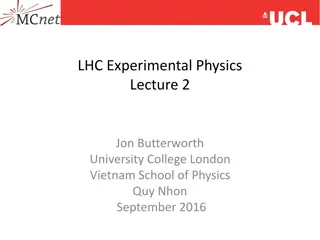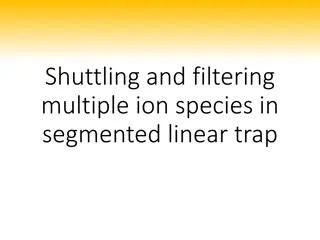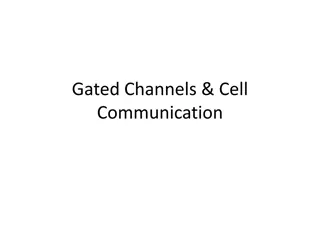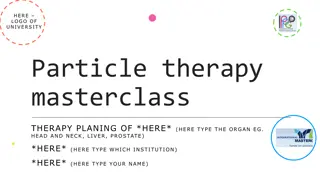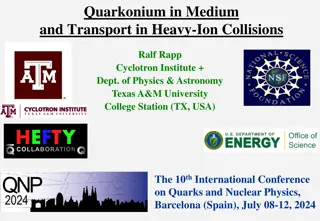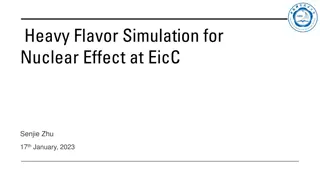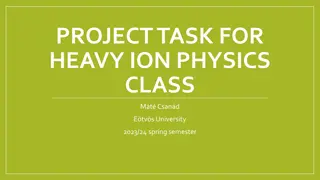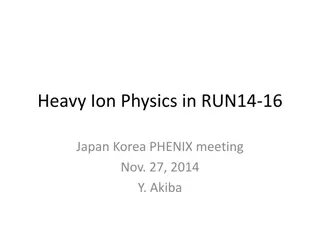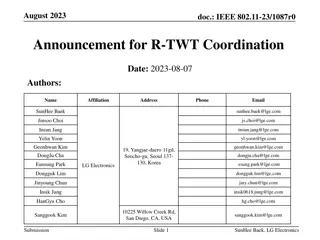Charm in Heavy Ion Collisions: Experimental Comparisons from SPS to LHC
Investigating charm suppression in heavy ion collisions at different energy levels, this study compares experimental data from SPS to LHC. Analysis suggests similar suppression at SPS and RHIC, with potential factors like recombination and direct J/ψ production influencing results. Uncertainties related to CNM effects underscore the need for further investigation to verify sequential suppression hypotheses.
Uploaded on Sep 24, 2024 | 1 Views
Download Presentation

Please find below an Image/Link to download the presentation.
The content on the website is provided AS IS for your information and personal use only. It may not be sold, licensed, or shared on other websites without obtaining consent from the author.If you encounter any issues during the download, it is possible that the publisher has removed the file from their server.
You are allowed to download the files provided on this website for personal or commercial use, subject to the condition that they are used lawfully. All files are the property of their respective owners.
The content on the website is provided AS IS for your information and personal use only. It may not be sold, licensed, or shared on other websites without obtaining consent from the author.
E N D
Presentation Transcript
C H I C Charm in Heavy Ion Collisions @ SPS J/ Suppression in A+A CHIC Physics motivations CHIC Experimental aspects 1. 2. 3. F. Fleuret - LLR 1
J/ Suppression in A+A SPS (17 GeV) .vs. RHIC (200 GeV) Compare 0<y<1 at SPS (NA50/NA60) |y|<0.35 at RHIC (PHENIX) ~ same y (~same xF) SIMILAR SUPPRESSION atSPS.vs.RHIC Assuming CNM effects amplitude are the same (possible within large RHIC uncertainties), two hypothesis : 1. Due to recombination process which exactly compensates a larger suppression expected at RHIC energies PHENIX Due to c suppression (and )only * SEQUENTIAL SUPPRESSION RAA(mid) > RAA(forward) 2. * direct J/ not suppressed F. Fleuret - LLR 2
J/ Suppression in A+A SPS (17 GeV) .vs. RHIC (200 GeV) Compare 0<y<1 at SPS (NA50/NA60) |y|<0.35 at RHIC (PHENIX) 1.2 < |y| < 2.2 at RHIC (PHENIX) After CNM effects correction: SIMILAR SUPPRESSION at SPS .vs. RHIC If recombination at RHIC, must be small Hint for sequential suppression ? ( c and melting ?) But LARGE CNM effects uncertainties not clear yet F. Fleuret - LLR 3
J/ Suppression in A+A RHIC (200 GeV) .vs. LHC (2.76 TeV) Compare 1.2 < |y| < 2.2 at RHIC (PHENIX) 2.5 < y < 4 at LHC (ALICE) LESS SUPPRESSION at LHC .vs. RHIC Assuming CNM effects amplitude are the same (or larger at LHC) : AA ALICE (Pb-Pb s = 2.76 TeV), 2.5<y<4, p NN = 0.2 TeV), 1.2<|y|<2.2, p NN s >0 (preliminary) 1.4 R T Could be due to recombination effects PHENIX (Au-Au >0 (arXiv:1103.6269) T 1.2 1 0.8 0.6 0.4 Caution : Needs CNM effects comparison 0.2 (*) ALICE <N > is weighted by N part coll 0 0 50 100 150 200 250 300 350 400 <N *> part F. Fleuret - LLR 4
J/ Suppression in A+A RHIC (200 GeV) .vs. LHC (2.76 TeV) Compare |y|<0.35 at RHIC (PHENIX) |y|<1 at LHC (CMS) MORE SUPPRESSION at LHC .vs. RHIC Assuming CNM effects amplitude are the same (or smaller at LHC) : pT>6.5 GeV/c no recombination applies larger suppression due to HDM effects ? PHENIX CMS Hint for sequential suppression ? (J/ melting) Caution : Needs CNM effects comparison F. Fleuret - LLR 5
J/ Suppression in A+A Similar suppression at SPS.vs.RHIC After CNM effects correction Larger suppression at LHC outside recombination regime CMS results (assuming CNM effects are the same or smaller) Smaller suppression at LHC inside recombination regime ALICE results (assuming CNM effects are the same of larger) Large uncertainties due to CNM effects Need to measure c to (dis)prove sequential suppression CHIC experiment F. Fleuret - LLR 6
CHIC Physics motivations 1. Measure c in A+A at SPS How c is suppressed relative to J/ ? What is the dependence with y, pT, centrality, ? Mandatory to draw the whole picture (SPS .vs. RHIC .vs. LHC) PRL 99, 132302 (2007) Need to be measured c measurement will answer this Why SPS ? c ? SPS best place to see full Sequential suppression J/ 1 Most central RHIC ? LHC ? No recombination at SPS 2 F. Fleuret - LLR 7
CHIC Physics motivations 2. Measure charmonium in p+A at SPS J/ and suppression in p+A collisions as a function of L NA50 J/ Measuring different charmonium states gives key information on nuclear absorption production mechanism. and Euro. Phys. J. C48 (2006) 329. J/ rapidity distribution in p+A collisions (asymetry wrt ycm=0) Measuring charmonium in a wide xF range is important to identify possible (anti)shadowing effects F. Fleuret - LLR 8
CHIC Physics motivations 2. Measure charmonium in p+A at SPS Measuring charmonium in a wide xF range is important to identify possible (anti)shadowing effects 2 M = sinh x y F CMS s E866, Phys. Rev. Lett. 84, 3256-3260 (2000) With M=3.1 GeV/c and s=17.2 GeV (158 GeV) xF = 1 yCMS = 1.7 With M=3.1 GeV/c and s=29.1 GeV (450 GeV) xF = 1 yCMS = 2.2 YCMS=2 xF = 0.8 Possible to access large xF if measuring charmonia at rapidity up to yCMS~2 F. Fleuret - LLR 9
CHIC Physics motivations 1. Measure c production in A+A How c is suppressed relative to J/ ? What is the dependence with y, pT, Npart, ? Mandatory to draw the whole picture (SPS .vs. RHIC .vs. LHC) Benchmark 1 : Measure c production within yCMS [-0.5, 0.5] 2. Measure charmonia production in p+A what is the dependence of charmonia suppression with rapidity ? Crucial to understand effects due to cold nuclear matter Benchmark 2 : Measure charmonium states within yCMS [-0.5, 2] F. Fleuret - LLR 10
CHIC Expected yields North Area Beamlines Need high intensity p and Pb beams (~ 107 Pb/sec) NA50/NA60 beam line not available (NA62) H2 beam line occupied by NA61 H4 and H8 available but need shielding for HI NA50: European Physical Journal C39 (2005) 335 New measurement of J/ suppression in Pb+Pb at 158 GeV/nucleon 35 days of data taking in 2000 ~1.107Pb/s over 5s bursts every 20s 4 mm thick Pb target (10% I) ~ 100 000 J/ + - within y* [0,1] (on tape) Expect fair amount of c: NJ/ ~ 60% direct + ~30% from c + ~10% from Same conditions as NA50 setup ~20 000 c expected within yCMS [-0.5,0.5] Expect more with thicker target (1cm for instance) F. Fleuret - LLR 11
CHIC Detector design Primary goals : c J/ + J/ + -in large yCMS range Detector features : very compact Spectrometer - Measure tracks before absorber M~20 MeV/c - Covers yCMS [-0.5, 2] need high segmentation Silicon technologies Calorimeter - Measuring in high 0 multiplicity environment ultra-granular EMCal (Calice) Absorber/trigger - Using 4.5 m thick Fe to absorb /K and low P +/- - Can use smaller absorber if Fe magnetized - Trigger to be defined (expected rate = 0.3 kHz) Expected performances tracking : long 1m within % 1 ~ P E % 20 ~ + - at yCMS= 0 1. 2. 3. Dipole field P 1. 2.5 T B 2. Calorimetry : E E F. Fleuret - LLR 12
CHIC Performances c2 in p+p collisions at s=17.8 GeV Sample: 20 000 events with Pythia 6.421 1 c2 J/ + - per event Smearing P /P = 1% Smearing E /E = 20%/ E Selections : Keep muons w/ -0.5 < ycms < 0.5 Keep muons w/ Pz > 7 GeV Keep muons w/ zvertex < 215 cm Keep photons w/ -0.5 < ycms < 0.5 Reject photons w/ M [100, 160] MeV/c Results : signal/bkg = 2.8 c2 in Pb+Pb at s=17.8 GeV Sample: 10 000 events minbias with Epos 1.6 1 pythia c2 embedded in each event Same selections as in p+p Reject if not in the same emisphere as J/ Results : signal/bkg = 3.6 F. Fleuret - LLR 13
Conclusion Many data on J/ at various energies, more to come. Still difficult to understand: Is there sequential screening ? When does recombination applies ? c is a key measurement to (dis)prove sequential screening. Because of its energy, SPS is the best place to start with. Thanks to new technologies (tracking, calorimetry), it is FEASIBLE. Let s do it ! fleuret@in2p3.fr F. Fleuret - LLR 14
backup F. Fleuret - LLR 15
Experimental landscape Current landscape Fixed target : SPS/CERN NA38/50/60 experiments sNN = 17 30 GeV Statistics :100 000 s J/ Data sets : p+A w/ A=p, d, Be, Al, Cu, Ag, W, Pb; S+U, In+In, Pb+Pb Small rapidity coverage (typically y [0,1]) Collider : RHIC/BNL Phenix, Star experiments sNN = 200 GeV Statistics : 1000 s J/ (10000 s since 2007) Data sets : p+p, d+Au, Cu+Cu, Au+Au Large rapidity coverage (y [-0.5,0.5], y [-2.2,-1.2] and y [1.2,2.2]) Collider : LHC/CERN Alice, CMS, Atlas experiments ( sNN = 5,5 TeV) Statistics : 100000 s J/ Data sets : p+p, Pb+Pb, p+Pb Large rapidity coverage (|y|<2.5 ATLAS/CMS, |y|<0.9 and -4.0 < y < -2.5 ALICE) Feedback : 4 key points 1. High statistics draw clear suppression pattern in Hot Nuclear Matter and Cold Nuclear Matter 2. Large data set draw clear suppression pattern in Cold Nuclear Matter 3. Large xF (rapidity) coverage understand suppression mechanism in Cold Nuclear Matter 4. As large sample of quarkonium states as possible understand suppression mechanism in Hot Nuclear Matter and Cold Nuclear Matter F. Fleuret - LLR 16
